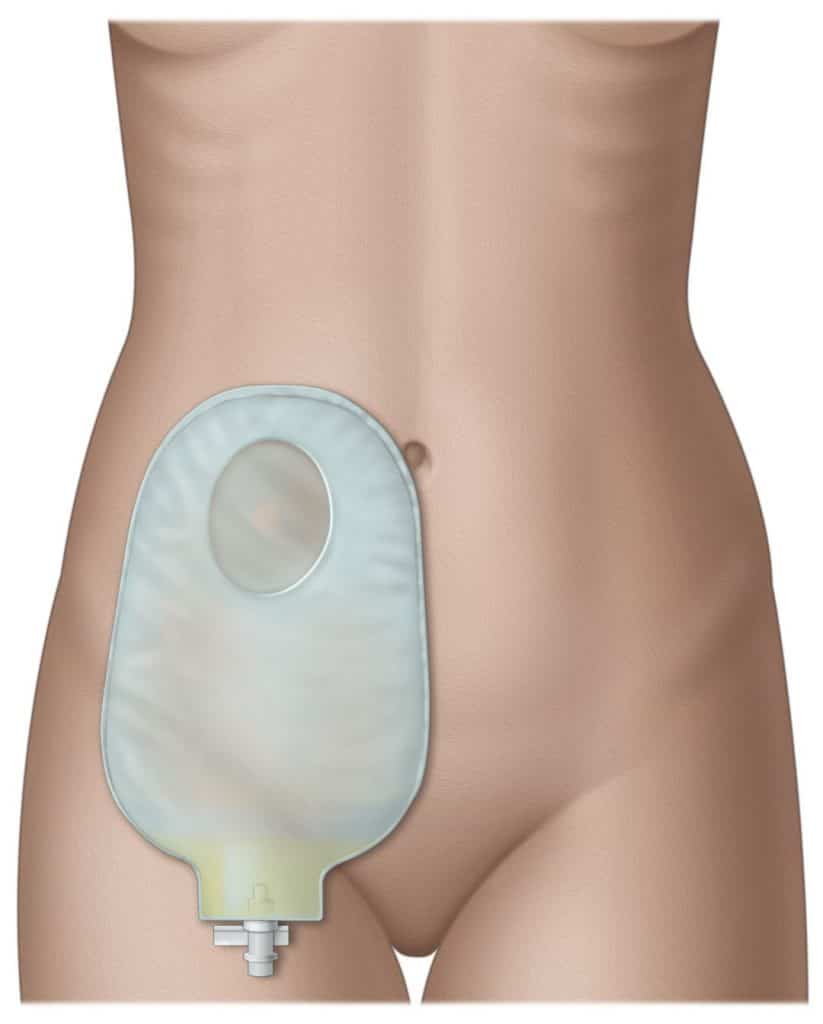Cystectomy - urinary diversion
Defintion
 This is a complex surgery that involves removing the entire bladder, prostate and seminal vesicles in men, and most often the uterus, ovaries and part of the vagina in women. Lymph nodes in the area are also removed.
This is a complex surgery that involves removing the entire bladder, prostate and seminal vesicles in men, and most often the uterus, ovaries and part of the vagina in women. Lymph nodes in the area are also removed.
After surgery, it is necessary to create a new urine outlet, which can be a "neobladder" or a channel created with the intestine that exits through an orifice in the abdomen, in the latter case, the patient uses a urine collection bag in the abdomen.
After removing the bladder from the lymph nodes, in the case of a radical cystectomy, the Da Vinci robotic system can facilitate the reconstruction of the urinary tract or the creation of a neobladder. This stage of urinary tract reconstruction can be performed totally intracorporeal using robotics, or openly with a smaller incision than the traditional one.
Radical cystectomy can be performed openly or minimally invasively (traditional or robotic laparoscopy). Less invasive techniques allow for smaller incisions, reduced bleeding and a faster recovery period for the patient. Studies show that the robotic technique has fewer incision-related complications, such as infections and hernias in the area.
In which cases is Radical Cystectomy indicated?
In patients with bladder tumors that are advanced or at risk of progression to more aggressive stages. The main indications are:
Tumors with invasion of the muscle layer of the bladder
Tumors classified as high grade, very large, that have recurred after previous treatments, or with other high risk criteria for disease worsening
Anesthesia
Open cystectomy is performed under general anesthesia. It requires a careful preoperative anesthetic evaluation because the operation presents many possible perioperative complications (hemorrhages, intestinal lesions, dehiscence of the anastomoses, lymphorrhea) moreover, acute manifestations in cardiac or chronically ill patients may occur. In patients with poor general condition. Patients at high anesthetic risk may benefit from palliative interventions (eg uretero-cutaneousostomy) in anticipation of subsequent treatments (chemo-radiotherapy).
Main surgical steps
The skin incision is made on the midline, from a few centimeters above the navel to the pubis (“supra-navel-pubic” incision). After incising the abdominal wall, it is a question of accessing the peritoneum (sac which surrounds the abdominal viscera), opening it and detaching the bladder from the peritoneal membrane; the vas deferens (canaliculi carrying sperm) are dissected and the ureters are isolated and detached from the bladder where they enter it.
The bladder is then detached from the rectal wall posteriorly until, after bladder mobilization is complete, the urethra is dissected and excision (excision) is completed. In the case of a male subject, the operative stage consists of the excision in a single block of the bladder, the prostate and the seminal vesicles and very often an excision of the erect nerves which run in close contact with the prostate. and urethra and which lead to a modification, until the disappearance, of the capacity to have a spontaneous erection.
In the case of a female subject, it may be necessary to remove, in addition to the bladder, the uterus and appendages and the anterior part of the vagina. For greater oncological radicality and for more correct staging, the iliac-obturator lindonodes are removed. If necessary, the intervention ends with the removal of the urethra which may require an additional incision of the perineum (between the scrotum and the anus) in men.
Urinary diversion
External diversions: stomas on the abdominal wall, themselves divided into direct (mono or bilateral) and indirect uretero-cutaneousostomies, which use the intestinal loops as reservoirs and can be continents.
Néovessie orthotopique
Not all patients undergoing radical cystectomy are candidates for orthotopic neobladder reconstruction. (eg, urethral involvement of the neoplastic process, advanced stage of the neoplasm, patient age, renal function, previous radiation therapy to the pelvis.)Once the gastrointestinal tract most suitable for urinary diversion has been identified and isolated, it will be modified according to the type of diversion envisaged, in order to obtain a spherical reservoir, at low pressure (i.e. which does not stretch until at least 200-300 cc of urine is deposited inside) and as much as possible devoid of the original characteristics of the organ from which it originated; in the case of the intestine, peristalsis (that is, that continuous movement that allows the intestinal material to progress towards the anus) must be abolished, otherwise incontinence will appear. This “Neobladder” is anastomosed to the urethra.
Bricker
The Bricker urinary diversion procedure continues to be one of the most widely used techniques today, thanks to its low complication rate and high patient satisfaction.
The technique consists of wrapping an ileal conduit whose distal end is sutured directly to the abdominal wall, obtaining a stoma through which urine will then be excreted.
Although originally described for the small intestine, it can be used using any intestinal segment that has the characteristics necessary for the required function. The most manageable method of performing this anastomosis is the excision of a small knob of serum, muscle tissue and mucosa from the bowel wall, the subsequent longitudinal incision of 0.5 cm from the distal end of the ureter, and in the subsequent anastomosis of the entire ureteral thickness with the entire thickness of the intestinal wall, and not only with the mucous membrane; in this case, a continuous suture and an discontinuous suture can be used. The anastomosis is then maintained with the insertion of a flexible catheter. The rate of postoperative stenosis for such an anastomosis varies between 4% and 22% (with an average of 6%).